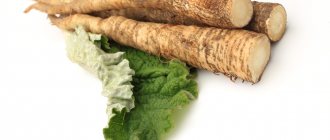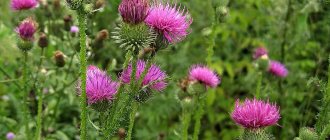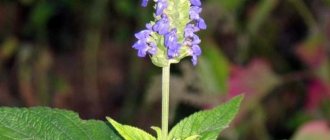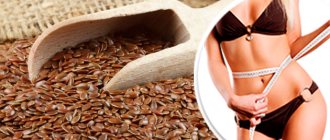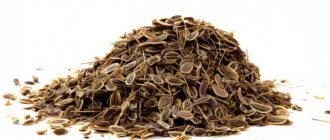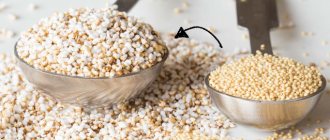Burdock (burdock) is a weed plant known to every person in our latitudes. These weeds stand out among other plants due to their large, rough leaves and basket-shaped inflorescences, which with their soft hooks cling to human clothing or animal fur, ensuring their spread. It was these burdock hooks that in the 50s of the 20th century served as the prototype for the creation of the Velcro fastener that is popular today.
But burdock is not only a widespread weed: it is a healing plant that has been used by herbalists since time immemorial to heal many skin ailments and diseases of internal organs.
How and where it grows
In Russia, the most common types of burdock are large and felt. They grow almost everywhere: they can often be seen on river banks, along roads, in vegetable gardens and forest clearings. They also love places where organic waste accumulates (landfills, manure heaps).
Content:
- How and where it grows
- Chemical composition
- Beneficial features
- Contraindications for use
- Use in folk medicine
- Burdock remedies
- Application in cosmetology
- conclusions
To ensure that harvested plants do not cause harm to health instead of benefit, when collecting raw materials (roots, leaves, fruits) of burdock, you must carefully select the places where it is collected. They should be located away from landfills, busy roads, agricultural lands and livestock complexes.
The main harvested raw material of this plant is its roots. The roots of one-year-old burdock are considered the most useful. It is recommended to collect them before hibernation - in September-October. It is at this time that the roots contain the highest possible concentration of nutrients. Burdock leaves are collected from July to September, when they are most juicy and fleshy, and the fruits are collected in July-August, that is, as they ripen.
Burdock roots are cleared of soil, washed and cut into pieces 10-15 cm in length. To dry, they are laid out in a thin layer on a thick sheet of paper in a dry but well-ventilated area.
Leaves and fruits are dried in a suspended state, avoiding exposure to sunlight. Dry roots are stored in dry, cool rooms for 5 years, leaves and fruits - up to 1 year (until the next harvest).
Most common dosage forms
Burdock is most often used in the form of tinctures, decoctions and ointments; juice, leaves and burdock oil are also effective in treatment. All these dosage forms heal wounds, relieve pain and inflammation. The popularity of the drugs is also due to the ease of their preparation at home.
Burdock leaves. They can be used both in their natural state and in crushed or mashed form. A whole burdock leaf is applied to the affected or sore area with the lower (gray, not green) side. If you use chopped burdock, then chop it coarsely or finely, crush it with a masher or a wooden spoon.
Juice. An excellent medicine with anti-inflammatory, bile- and diuretic, antiallergic and antibacterial effects. Burdock juice helps against rheumatic and diabetic symptoms, promotes more efficient functioning of the liver, intestines and stomach, improves blood composition, normalizes metabolism and protein absorption. Burdock juice is also applied to wounds, burns, ulcers, cuts and rubbed into the scalp to strengthen hair. To obtain juice, the leaves are passed through a meat grinder.
Infusions. They use burdock roots, flowers and leaves, both dry and fresh. Such infusions are used as external and internal remedies. The drug can be prepared cold or hot. In the first case, parts of the plant are crushed and filled with water at room temperature, then closed for a certain time. Using the hot method, use boiling water or preheated vegetable oil. The resulting infusion is filtered through gauze folded in three layers.
Tinctures. To prepare them, use seeds, crushed roots or leaves of burdock, which are poured with vodka or alcohol, and then infused in a cool, dark place. The finished tincture is filtered or left in its original form. The length of time the plant particles remain in alcohol increases the healing properties of the medicine used for both internal and external use.
Decoctions. Such medicines can be prepared in different ways, but the basic recipe will be the same for all cases - parts of the plant are poured with water and boiled over low heat. The finished decoction is filtered and taken orally for rickets, kidney, liver and bladder diseases, diabetes mellitus and malignant neoplasms. With the help of decoctions, compresses and lotions are made, as well as baths - to treat rheumatism, joint pain and skin diseases.
Ointments. As a rule, crushed parts of the plant are used (usually leaves and roots), they are mixed with animal fat, or decoctions and infusions are subjected to prolonged boiling and evaporation over low heat. Ointments are used to treat burns and wounds, hair loss, skin diseases, etc.
Root extract. Juice or extract of active substances from the root. It has a laxative, anti-inflammatory, diuretic, antipyretic and choleretic effect. Effective for poisoning of various types - chemical, toxic and alcoholic, for digestive disorders, diseases of the spine and joints. Eliminates skin problems and is used for viral infections, which are characterized by an increase in body temperature. Alleviates the serious condition of cancer patients. It has contraindications in the form of a specific reaction of the body to the drug.
Burr oil. There are legends about the creation of this drug, but it has existed for centuries. In Soviet times, burdock oil was considered the only remedy effective for problems with the scalp and hair, which was recognized by official medicine. The drug demonstrates high effectiveness, since it contains all the active substances of the plant.
It has a powerful effect on eliminating dandruff and itching, dry conditions, making hair roots stronger, preventing hair loss, restoring and strengthening its structure. Especially recommended for chemically damaged hair that has become thin and lost its shine.
Before preparing the oil, the burdock root is washed with running water and grated on a fine grater. Then rub it on a fine grater and fill it with vegetable oil. You need to infuse the product in a cool, dark room for 24 hours, then keep it on low heat for 15 minutes, without bringing it to a boil. Next, the drug is filtered and poured into a glass container.
Burdock leaves can also be useful for making salads and soups.
Chemical composition
Burdock leaves contain a lot of tannins, essential oils and mucus. This chemical composition of the leaves allows them to be used as an external hemostatic and wound healing agent.
The seeds of this plant contain a lot of fatty acids and the lignan glycoside arctiin (eleutheroside F). This substance exhibits pronounced antibacterial and hypoglycemic properties.
The chemical composition of different parts of burdock differs significantly, but the roots of burdock are the richest in useful substances. Fresh roots of one-year-old burdock contain up to 18 g of carbohydrates (of which 3 g of dietary fiber), 1.5-1.6 g of proteins and up to 0.2 g of fat. The calorie content of 100 g of raw burdock roots is 72-75 kcal.
Burdock roots contain significant amounts of:
- inulin;
- fatty acid;
- phytosterols;
- essential oils;
- resins;
- tannins;
- bitterness;
- vitamins;
- minerals;
- mucus.
Fatty acids, of which the largest amount are stearic and palmitic, are involved in the synthesis of cell membranes and the main substances of connective tissue - hyaluronic acid, collagen and elastin.
Burdock phytosterols (stigmasterol, sitosterol) play the role of antagonists of animal cholesterol, preventing its deposition in the walls of blood vessels as part of atherosclerotic plaques.
Burdock roots contain many vitamins B, C, E. They are a source of potassium, manganese, magnesium, and copper.
Due to the high concentration of potassium, burdock raw material has a pronounced diuretic effect. Vitamins and minerals
| Name | Content per 100 g of fresh roots, milligrams |
| Vitamin B1 (thiamine) | 0,01 |
| Vitamin B2 (riboflavin) | 0,03 |
| Vitamin B4 (choline) | 11,7 |
| Vitamin B5 (pantothenic acid) | 0,32 |
| Vitamin B6 (pyridoxine) | 0,24 |
| Vitamin B9 (folic acid) | 0,023 |
| Vitamin C (ascorbic acid) | 3,0 |
| Vitamin E (tocopherol) | 0,38 |
| Magnesium | 0,038 |
| Potassium | 308,0 |
| Phosphorus | 51,0 |
| Sodium | 5,0 |
| Calcium | 41,0 |
| Iron | 0,8 |
| Manganese | 0,23 |
| Zinc | 0,33 |
| Copper | 0,08 |
| Selenium | 0,0007 |
The bitterness contained in burdock raw materials, together with inulin, prevents surges in glucose levels in patients with diabetes.
Best before date
24 months
Vitamins with similar effects
- Maxiflorum with Valerian (Oral tablets)
- Incas gold. Men's Formula (Oral Tablets)
- Encaps (Capsule)
- Influence (Capsule)
- Set of herbs No. 4 (Oral tablets)
- Narosan Orange (Oral liquid)
- Marine calcium for children with iron (Oral tablets)
- Marine calcium for children with manganese (Oral tablets)
- Pankramin (Powder for oral solution)
- Pantohematogen "Altamar™-1" (Capsule)
Description of the vitamin Burdock Seeds is intended for informational purposes only. Before starting to use any drug, it is recommended to consult a doctor and read the instructions for use. For more complete information, please refer to the manufacturer's instructions. Do not self-medicate; EUROLAB is not responsible for the consequences caused by the use of information posted on the portal. Any information on the project does not replace consultation with a specialist and cannot be a guarantee of the positive effect of the drug you use. The opinions of EUROLAB portal users may not coincide with the opinions of the site Administration.
Are you interested in vitamin Burdock Seeds? Do you want to know more detailed information or do you need a doctor's examination? Or do you need an inspection? You can make an appointment with a doctor - the Euro lab is always at your service! The best doctors will examine you, advise you, provide the necessary assistance and make a diagnosis. You can also call a doctor at home . Euro lab clinic is open for you around the clock.
Attention! The information presented in the vitamins and dietary supplements section is intended for informational purposes and should not be a basis for self-medication. Some of the drugs have a number of contraindications. Patients need to consult a specialist!
If you are interested in any other vitamins, vitamin-mineral complexes or dietary supplements, their descriptions and instructions for use, their analogues, information about the composition and form of release, indications for use and side effects, methods of use, dosages and contraindications, notes about the prescription of the drug for children, newborns and pregnant women, price and consumer reviews, or you have any other questions and suggestions - write to us, we will definitely try to help you.
Beneficial features
Products made from burdock roots have a variety of beneficial properties when taken orally:
- diuretic;
- diaphoretic;
- choleretic;
- antiseptic;
- antiallergic;
- hypoglycemic;
- wound healing;
- anti-inflammatory;
- laxative.
Burdock inulin is a polysaccharide that is a plant analogue of human insulin. It improves the penetration of glucose into cells, reducing its concentration in the blood. The presence of inulin in burdock normalizes the metabolism of fats and carbohydrates and restores normal intestinal microflora. In the intestines, this polysaccharide absorbs various toxic substances, including poisons.
Tannins exhibit wound-healing and hemostatic properties, and mucus has an enveloping effect on the mucous membranes of the digestive organs.
Contraindications for use
Burdock products are contraindicated for use if you have an individual intolerance to the chemical composition of the plant itself or other ingredients included in the product. It is not recommended to use burdock products for pregnant and lactating women.
Home remedies made from burdock may exhibit dangerous properties if its raw materials were collected in environmentally unfavorable places.
Such plants absorb many contaminants - pollutants (salts of heavy metals, pesticides, nitrates, radionuclides), so raw materials obtained from them can cause poisoning or allergic reactions.
Use in folk medicine
A pharmaceutical medicine called “burdock oil” is recommended by dermatologists and trichologists for hair problems. Externally, burdock products are also used for:
- eczema;
- furunculosis;
- skin itching;
- dermatitis;
- insect bites (mosquitoes, wasps, bees);
- snake bites;
- joint pain (for compresses);
- baldness.
For external use, use fresh leaves, a decoction of burdock roots or burdock oil.
For diseases of the digestive tract
A decoction and infusion of burdock roots is successfully used in the treatment of:
- heartburn;
- gastritis;
- ulcers of the stomach and duodenum;
- pancreatitis;
- atony of the gallbladder;
- constipation;
- hemorrhoids.
Taking burdock products internally improves digestion and stimulates the secretion of digestive juices.
For renal pathologies
Due to its diuretic properties, products based on burdock root are used for renal pathologies accompanied by edema syndrome. For urolithiasis, a decoction or infusion of burdock root helps to dissolve and remove small stones from the urinary tract. Burdock remedies are especially effective for urate stones (made from uric acid salts). The acids of burdock roots contain the enzyme uricase, which promotes the dissolution of urates and excretion in the urine.
For cancer
Traditional medicine recommends the use of products based on burdock raw materials for the complex treatment of oncological diseases of different localizations. For some tumors, folk remedies made from burdock are simultaneously taken internally and used externally. For example, for breast cancer, fresh burdock leaves can be applied externally to the site of the tumor, and a decoction or infusion from its roots can be taken internally.
Folk remedies from burdock for cancer do not replace the main treatment (chemotherapy, surgical treatment), but only help to inhibit the growth of tumors and improve the general condition of the patient during treatment.
Remedies from burdock roots are also used internally for:
- diabetes mellitus of the first or second type;
- gout;
- rheumatic diseases;
- prostatitis;
- prostate adenoma;
- allergies, including to pollen;
- bronchial asthma.
Burdock decoction also helps with poisoning with mercury and other heavy metal salts. In this case, we are not talking about acute poisoning, which requires the immediate use of specific antidotes, but about chronic intoxication (occupational hazards, addictions, unfavorable living conditions). In these cases, the medicine from burdock must be taken for a long time.
Medicinal properties of burdock
Is burdock used for arthritis? The plant is considered one of the most common remedies for treating joint diseases. Burdock helps cleanse them of salt deposits and uric acid. The plant has healing qualities, is suitable for treating joints and generally has no contraindications. It is suitable for every patient, unlike medications.
The medicinal properties of burdock allow it to be used for preparing compresses, ointments and tinctures. At the same time, all parts of the plant find their use for prevention and therapy.
Burdock is also widely used in cosmetology. It is included in creams, masks, tonics, balms for the face and body.
The plant is able to remove toxins, stones and salts from the body. For kidney diseases, a specialist prescribes a decoction of burdock along with medications.
The anti-inflammatory and analgesic qualities of burdock are successfully used to treat arthritis, rheumatism, osteochondrosis, polyarthritis and radiculitis.
Burdock remedies
Healing remedies from burdock can be prepared from its leaves, fruits, and roots. They are used externally (for compresses, lotions) and internally. For internal use, decoctions, infusions, tinctures are prepared, and juice is squeezed from fresh roots.
Decoction
Chopped burdock roots (2 tablespoons) are poured into 1/2 liter of boiling water, boiled for 20 minutes, filtered. Take 100 ml three times a day.
Cold infusion
1 teaspoon of crushed roots is poured into 250 ml of boiled water at room temperature and left for at least 5 hours (for example, from evening to morning). After straining, drink warm throughout the day.
Juice from roots
Best materials of the month
- Coronaviruses: SARS-CoV-2 (COVID-19)
- Antibiotics for the prevention and treatment of COVID-19: how effective are they?
- The most common "office" diseases
- Does vodka kill coronavirus?
- How to stay alive on our roads?
Treatment with juice from fresh burdock roots is carried out in May-June, when burdock roots contain the greatest amount of useful substances. The dug up roots are crushed to a pulp (grated or passed through a meat grinder), and the juice is squeezed out. Take 1 tbsp orally. spoon at least 3 times a day. The continuous course of treatment should not exceed one week, then a break for the same period is required. After this, the course is repeated.
The juice is consumed internally for liver diseases, and externally for the treatment of dermatological diseases and tumors.
Recipes with burdock for joint pain
Burdock is certainly an amazing plant, whose potential can comprehensively affect the body. However, the beneficial result does not appear immediately and in order to feel clear relief, you should wait for some time. Treatment of joints with burdock will be more beneficial if you simultaneously take pharmaceuticals, undergo physical therapy or exercise therapy.
Ointments based on burdock
Here we offer several recipes that can help with certain joint complications.
- Serious knee bruises are treated by applying a burdock leaf. At the same time, do not forget that the sheet should be placed with the bottom side on the sore spot. Wrap your knee tightly and leave the bandage on for a day. For milder injuries (eg abrasions or scratches), to speed up healing, the sheet is kneaded and then applied to the problem area.
- If you want the result of treatment of an intervertebral hernia to be noticeable, in addition to the main therapy, make lotions with a decoction of burdock flowers or leaves. To prepare it, bring 200 ml of water with 20 g of any parts of the plant to a boil. A cloth soaked in this remedy is applied to the affected area.
- Burdock compress helps during periods of exacerbation of rheumatoid and arthritic pain. Before applying, wipe the sheet with alcohol (this increases the effectiveness of the product). apply it so that the upper side lies tightly on the sore joint, wrapping it in a plastic bag and a warming cloth.
- A quick-acting compress is made from crushed and moldy burdock leaves. For mold to appear, place a jar with chopped leaves in a sunlit place.
- Steamed burdock root is used as a lotion for rheumatism. You can prepare the product by pouring boiling water over the chopped roots.
- A decoction of burdock roots is effective in the treatment of arthrosis. 1 tablespoon of crushed roots is brewed in half a liter of boiling water. Then the primary decoction is boiled for half an hour over low heat. The resulting product is recommended to be consumed three times a day before meals, 100 grams.
- For deforming osteoarthritis, a tincture of burdock root in vodka helps. The root substrate is mixed with honey in equal parts. For 200 gr. vodka take 1 tbsp. l. mixtures. After a week, the finished tincture can be consumed in 20-30 g doses. before eating.
Burdock, despite its simplicity, can bring significant benefits in the treatment and prevention of diseases of osteochondral tissue. By regularly taking medications based on it, you can significantly improve the condition of your joints and bones. However, we should not forget about an integrated approach to treatment.
Source
Application in cosmetology
Burdock root products are often used in cosmetology to strengthen hair and get rid of dandruff. For these purposes, it is more convenient to use pharmaceutical products made from burdock: pure burdock oil, shampoos or balms based on it. From burdock oil you can prepare complex remedies that help with itchy scalp: with the addition of a decoction of calendula, chamomile or hop cones.
Regularly rubbing burdock oil into the scalp is useful during chemotherapy courses for the treatment of cancer. It helps maintain the vitality of hair follicles and accelerate hair regrowth after hair loss.
Burdock in national cuisines
Edible burdock is cultivated in China, Japan and Korea. Its juicy, tasty and slightly sweet roots are eaten even raw (which should not be done with the roots of wild burdock). If you fry or bake them, they will be covered with a sweet golden brown crust. Cutlets and flatbreads are prepared from burdock roots; young leaves are used in soups and salads. As a vegetable plant, burdock is popular in France.
In our country, burdock is not cultivated for food purposes. However, in the old days, during famine years, wild burdock was often eaten. Young leaves were used to prepare salads and soups, and the roots, after drying, were ground into powder, which was added to rye and wheat flour when baking bread. In Siberia and the Caucasus, burdock has long been revered as a vegetable plant. In spring, young leaves and succulent petioles were eaten. Roots chopped and boiled in sugar syrup can be an excellent treat. So the burdock plant is not at all useless.
